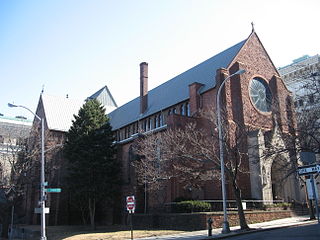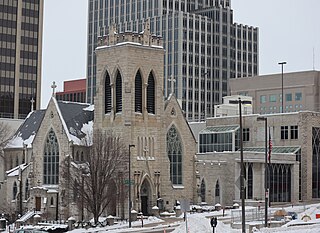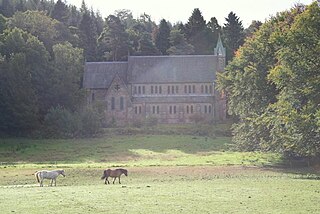
Ullet Road Church is a Unitarian church at 57 Ullet Road, Sefton Park, Liverpool. Both the church and its attached hall are separately recorded in the National Heritage List for England as designated Grade I listed buildings. It was the first place of worship in the United Kingdom to register a civil partnership for a same-sex couple. It is a member of the General Assembly of Unitarian and Free Christian Churches, the umbrella organisation for British Unitarians.

St John's Cathedral is the cathedral of the Anglican Diocese of Brisbane and the metropolitan cathedral of the ecclesiastical province of Queensland, Australia. It is dedicated to St John the Evangelist. The cathedral is situated in Ann Street in the Brisbane central business district, and is the successor to an earlier pro-cathedral, which occupied part of the contemporary Queens Gardens on William Street, from 1854 to 1904. The cathedral is the second-oldest Anglican church in Brisbane, predated only by the extant All Saints church on Wickham Terrace (1862). The cathedral is listed on the Queensland Heritage Register.

Patrick Charles Keely was an Irish-American architect based in Brooklyn, New York, and Providence, Rhode Island. He was a prolific designer of nearly 600 churches and hundreds of other institutional buildings for the Roman Catholic Church or Roman Catholic patrons in the eastern United States and Canada, particularly in New York City, Boston and Chicago in the later half of the 19th century. He designed every 19th-century Catholic cathedral in New England. Several other church and institutional architects began their careers in his firm.

Christ Episcopal Church is a historic Episcopal church located at 43 South Broadway in Tarrytown, New York. Topped by a modest tower, the ivy-covered red brick church was built in 1837 and maintains an active congregation to the present day. The church also includes the San Marcos Mission, a Spanish-language ministry.

St. Joseph's Episcopal Church, now known as St. Matthew's-St. Joseph's Episcopal Church, is a historic Episcopal church located at 8850 Woodward Avenue in Detroit, Michigan, and is part of the Episcopal Diocese of Michigan. It was added to the National Register of Historic Places in 1982.

The Cathedral of All Saints, Albany, New York, is located on Elk Street in central Albany, New York, United States. It is the central church of the Episcopal Diocese of Albany and the seat of the Episcopal Bishop of Albany. Built in the 1880s in the Gothic style and designed by Robert W. Gibson, it was listed on the National Register of Historic Places in 1974. Previously it had been recognized as a contributing property to the Lafayette Park Historic District, listed on the Register in 1970.

St. John's Episcopal Church is an antebellum-era church located at 2326 Woodward Avenue in Downtown Detroit, Michigan. It is the oldest church still standing on Woodward Avenue, an area once called Piety Hill for its large number of religious buildings. The church was listed on the National Register of Historic Places in 1982 and designated a Michigan State Historic Site in 1987.

The Soul Harvest Ministries is located at 16300 Woodward Avenue in Highland Park, Michigan. It was built in 1916 as the First United Methodist Church and listed on the National Register of Historic Places in 1982.

Trinity Cathedral is located in Downtown Omaha, Nebraska. Nebraska's first Episcopal parish, Trinity was established in 1856, and became the state's first Episcopal cathedral in 1872. Designed by noted English architect Henry G. Harrison in 1880, the cathedral was consecrated on November 15, 1883. It was added to the National Register of Historic Places in 1974. Today Trinity Cathedral is considered one of the most beautiful churches in Omaha.

St. Luke's Episcopal Church is located in Beacon, New York, United States. The church complex of four buildings and a cemetery takes up a 12-acre (4.9 ha) parcel between Wolcott, Rector, Phillips and Union Streets. It was founded in 1832 as a religious school that soon became St. Anna's Church of Fishkill Landing.

St. Paul's Protestant Episcopal Church, more commonly called Old St. Paul's Church today, is a historic Episcopal church located at 233 North Charles Street at the southeast corner with East Saratoga Street, in Baltimore, Maryland, near "Cathedral Hill" on the northern edge of the downtown central business district to the south and the Mount Vernon-Belevedere cultural/historic neighborhood to the north. It was founded in 1692 as the parish church for the "Patapsco Parish", one of the "original 30 parishes" of the old Church of England in colonial Maryland.
Jeremiah O'Rourke, FAIA,, was an Irish-American architect known primarily for his designs of Roman Catholic churches and institutions and Federal post offices. He was a founder of the Newark-based architectural firms of Jeremiah O'Rourke and Jeremiah O'Rourke & Sons.

Saint James' Episcopal Church is a historic church at 533 Bingham Avenue in Sault Ste. Marie, Michigan. It was added to the National Register of Historic Places in 1998.

Immanuel Presbyterian Church is a High Victorian Gothic-styled church built 1873–75 in Milwaukee, Wisconsin. In 1974 it was added to the National Register of Historic Places. Additionally, it was designated a landmark by the Milwaukee Landmarks Commission in 1969.

St Paul's Anglican Cathedral is an Australian heritage-listed cathedral at 89 William Street, Rockhampton, Rockhampton Region, Queensland. It was designed principally by Annersley Voysey and built from 1883 to 1953. It is also known as St Paul's Church of England and St Paul's Church of England Cathedral. It was added to the Queensland Heritage Register on 21 October 1992. The associated hall and offices were listed on the Queensland Heritage Register on 23 June 2000.

The Church of St Teresa of Avila in Everton Road, Birkdale, Southport, Sefton, Merseyside, England, is an active Roman Catholic church in the diocese of Liverpool. It was built in 1897–98 and designed by the architectural partnership of James Sinnott, Bernard Sinnott & Daniel Powell. The church, together with its attached presbytery, is recorded in the National Heritage List for England as a designated Grade II listed building.

The Church of St Mary of the Assumption is in Yorkshire Street, Burnley, Lancashire, England. It is an active Roman Catholic parish church in the diocese of Salford. The church is recorded in the National Heritage List for England as a designated Grade II listed building. It was built between 1846 and 1849 to replace a smaller chapel on a different site. The church was designed by Weightman and Hadfield in Decorated style, and a chapel was added to it in 1879.

St. Paul the Apostle Church is a historic Catholic church in the city of Mechanicville, New York, United States of America. It is presently part of the parish of All Saints on the Hudson.

St Margaret's Church is a church of the Scottish Episcopal Church near Aberlour in Moray, Scotland. It is Gothic in style, built mostly of tooled granite rubble, and has a cruciform layout with an east–west oriented nave, transepts to the north and south, and a slender tower at the south-west corner. Its interior is lavishly decorated with polished granite columns topped with ornately carved capitals, marble chancel furniture, and many stained glass windows depicting saints and biblical scenes.

All Saints' Episcopal Church is a historic Episcopal parish church in Austin, Texas, United States. Built in 1899 on the edge of the University of Texas at Austin campus, the church has long-standing connections with the university's student body and faculty. The chapel was a project of Episcopal Bishop George Herbert Kinsolving, whose crypt is located under the church. It has been designated as a City of Austin Historic Landmark since 1980 and a Recorded Texas Historic Landmark since 2014, and it was listed on the National Register of Historic Places in 2015.






















